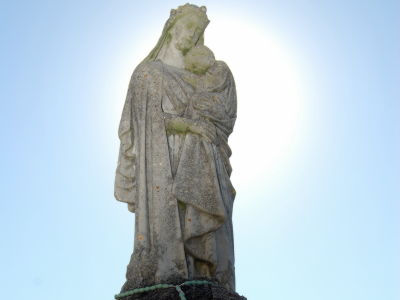Why is the 'devil' drawn as having 'horns and hooves'?

When ``devils'' appear in fantasy works, anime and games, they are often depicted with ``goat-like horns'' and ``goat-like hooves''. Historians are divided as to when such depictions of demons became popular and where they came from.
Why does the devil have horns and hooves?

``The devil is not mentioned in the Bible,'' said Marina Montesano, a professor of medieval history at the University of Messina in Italy, in an article contributed to National Geographic . According to Montesano, the devil is identified with the snake that tempted Eve to eat the fruit of knowledge in the Garden of Eden, but there was no mention of horns or hooves. Also, in medieval and Renaissance religious paintings, images of demons with horns and hooves do not appear.
For example, a 6th-century mosaic in the Basilica of Sant'Apollinare Nuovo in Italy depicts Satan , the devil, in the form of a 'blue angel'. Also, in a 15th-century painting depicting St. Augustine facing the devil, the devil is depicted as 'a dragon-like creature with bat-like wings.'

For this reason, some historians believe that ``early Christian writers named the god

Other historians suggest that goats and the underworld are traditionally associated with the devil as the reason for its goat-like features. In the Old Testament '
In a 2013 study, Alexander Klik, a historian at the Hebrew University, said, 'Depictions of demons with horns and hooves have their origins in early Jewish literature, dating back to the Jewish period and pre-Christian times. can be found in the Apocalypse of Baruch, written in Greek in The Apocalypse of Baruch mentions a 'demonic race with the hind legs of a donkey' who built the bottom layer of the Tower of Babel, and this passage suggests that the concept of a satyr-like demon was a Jewish concept of the time. Mr. Klik points out that it shows that it existed in thought.

On the other hand, Bristol University historian Ronald Hutton suggests that depictions of horned demons began in the 19th century, much later than Crick points out. Hutton said that the association between Pan and the devil came from around the 19th century, when new pagan beliefs challenged the dominant Christian beliefs in Europe, leading to goat-like horns. It is said that the appearance of Pan with hooves has permeated as the appearance of the devil.
Hutton said, 'The shift to the modern stereotypical image of the devil, goat horns, legs and goatee, is 19th century, and the contemporary literary focus on Parn as an increasingly prized 'country god'.' It seems to come from artistic worship.'
Related Posts:
in Note, Posted by log1e_dh







